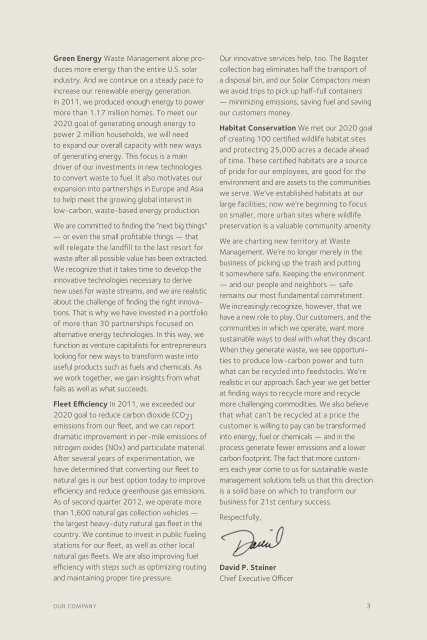2012 Sustainability Report - Executive Summary - Waste Management
2012 Sustainability Report - Executive Summary - Waste Management
2012 Sustainability Report - Executive Summary - Waste Management
Create successful ePaper yourself
Turn your PDF publications into a flip-book with our unique Google optimized e-Paper software.
Green Energy <strong>Waste</strong> <strong>Management</strong> alone produces<br />
more energy than the entire U.S. solar<br />
industry. And we continue on a steady pace to<br />
increase our renewable energy generation.<br />
In 2011, we produced enough energy to power<br />
more than 1.17 million homes. To meet our<br />
2020 goal of generating enough energy to<br />
power 2 million households, we will need<br />
to expand our overall capacity with new ways<br />
of generating energy. This focus is a main<br />
driver of our investments in new technologies<br />
to convert waste to fuel. It also motivates our<br />
expansion into partnerships in Europe and Asia<br />
to help meet the growing global interest in<br />
low-carbon, waste-based energy production.<br />
We are committed to finding the “next big things”<br />
— or even the small profitable things — that<br />
will relegate the landfill to the last resort for<br />
waste after all possible value has been extracted.<br />
We recognize that it takes time to develop the<br />
innovative technologies necessary to derive<br />
new uses for waste streams, and we are realistic<br />
about the challenge of finding the right innovations.<br />
That is why we have invested in a portfolio<br />
of more than 30 partnerships focused on<br />
alternative energy technologies. In this way, we<br />
function as venture capitalists for entrepreneurs<br />
looking for new ways to transform waste into<br />
useful products such as fuels and chemicals. As<br />
we work together, we gain insights from what<br />
fails as well as what succeeds.<br />
Fleet Efficiency In 2011, we exceeded our<br />
2020 goal to reduce carbon dioxide (CO 2)<br />
emissions from our fleet, and we can report<br />
dramatic improvement in per-mile emissions of<br />
nitrogen oxides (NOx) and particulate material.<br />
After several years of experimentation, we<br />
have determined that converting our fleet to<br />
natural gas is our best option today to improve<br />
efficiency and reduce greenhouse gas emissions.<br />
As of second quarter <strong>2012</strong>, we operate more<br />
than 1,600 natural gas collection vehicles —<br />
the largest heavy-duty natural gas fleet in the<br />
country. We continue to invest in public fueling<br />
stations for our fleet, as well as other local<br />
natural gas fleets. We are also improving fuel<br />
efficiency with steps such as optimizing routing<br />
and maintaining proper tire pressure.<br />
Our innovative services help, too. The Bagster<br />
collection bag eliminates half the transport of<br />
a disposal bin, and our Solar Compactors mean<br />
we avoid trips to pick up half-full containers<br />
— minimizing emissions, saving fuel and saving<br />
our customers money.<br />
Habitat Conservation We met our 2020 goal<br />
of creating 100 certified wildlife habitat sites<br />
and protecting 25,000 acres a decade ahead<br />
of time. These certified habitats are a source<br />
of pride for our employees, are good for the<br />
environment and are assets to the communities<br />
we serve. We’ve established habitats at our<br />
large facilities; now we’re beginning to focus<br />
on smaller, more urban sites where wildlife<br />
preservation is a valuable community amenity.<br />
We are charting new territory at <strong>Waste</strong><br />
<strong>Management</strong>. We’re no longer merely in the<br />
business of picking up the trash and putting<br />
it somewhere safe. Keeping the environment<br />
— and our people and neighbors — safe<br />
remains our most fundamental commitment.<br />
We increasingly recognize, however, that we<br />
have a new role to play. Our customers, and the<br />
communities in which we operate, want more<br />
sustainable ways to deal with what they discard.<br />
When they generate waste, we see opportunities<br />
to produce low-carbon power and turn<br />
what can be recycled into feedstocks. We’re<br />
realistic in our approach. Each year we get better<br />
at finding ways to recycle more and recycle<br />
more challenging commodities. We also believe<br />
that what can’t be recycled at a price the<br />
customer is willing to pay can be transformed<br />
into energy, fuel or chemicals — and in the<br />
process generate fewer emissions and a lower<br />
carbon footprint. The fact that more customers<br />
each year come to us for sustainable waste<br />
management solutions tells us that this direction<br />
is a solid base on which to transform our<br />
business for 21st century success.<br />
Respectfully,<br />
David P. Steiner<br />
Chief <strong>Executive</strong> Officer<br />
our company 3
















